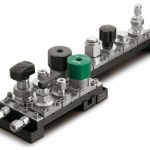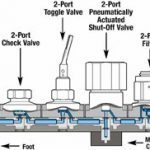Sample systems are a key part of analyser systems in the chemical and petrochemical industries. Monitoring and controlling chemical processes using instrumental methods of analysis contributes significantly to product quality, effective use of energy and raw materials, environmental performance, safety and overall plant profitability, and the advantages of miniature modular technology can help reduce the cost of building, operating and maintaining sample systems.
John Wawrowski
There is consensus within industry that improvements are needed in sample handling and delivery systems, where as much as 80% of the problems associated with process analysis occur. During the past two decades, analytical devices have become more capable and reliable; the computers and software that drive and operate the systems have become more sophisticated, powerful and user-friendly. However, the basic design of the sample handling and delivery systems serving these analysers has not kept pace with their advanced technology.
Similarly, sample handling and delivery system technologies have failed to keep pace with general economic and industry trends that are driving changes in process plants. These trends have resulted in a decrease in technical and maintenance staff in process plants, leading to increased reliance on suppliers who offer turnkey solutions, remote access capabilities and greater intelligence and automation in process analysers and analysis systems.
The incentive for industry to adopt a new sampling system design is the improved performance of the analyser systems; the reduced costs for designing, building and installing these systems; and the lower operating and maintenance costs. One important way to meet these needs is to make sampling systems miniature, modular and intelligent.
Looking to the future
Recognising the need for improvement, Swagelok has taken part in the New Sampling/Sensor Initiative (NeSSI) – which aims to facilitate state-of-the-art evaluation and development of the next generation of modular sample system designs – with the Center for Process Analytical Chemistry (CPAC) at the University of Washington. A joint industry-academic research consortium, CPAC’s mission is to develop new analytical chemistry methods, techniques and equipment.
One key element identified in the development of the modularisation strategy is open architecture. The Instrumentation, Systems and Automation Society (ISA) SP76 Composition Analysers Committee recognised the need for a standard for the seal between the platform or substrate and the surface-mounted functional components, so that components from different manufacturers could be integrated into a single system. The standard, ANSI/ISA 76.00.02, was issued in June 2002.
MPC advantages
In response to industry needs for improvements in process and analyser sampling systems, Swagelok developed the new modular platform components (MPC) system (Fig. 1). The unique design of the Swagelok MPC system consists of a layer of fluid control components – including shut-off, needle, metering, toggle and check valves, as well as filters – mounted on top of a substrate layer containing specialised channel and flow components. It meets all requirements of the ANSI/ISA 76.00.02 specification for the 1.5 in. (38.2 mm) footprint.
A typical MPC assembly, which provides a compact fluid distribution system with a reduced footprint for efficient use of component space, is shown in Figure 2. The surface-mount layer is the top layer that provides the functionality of the system through various surface-mounted components, which are all available in a variety of styles with 2- or 3-port surface-mount bodies. The substrate and manifold layers combine to form the conduit for the system fluid, and they can be customised for any flow configuration. The substrate layer provides the flow path between the surface-mounted components, while the manifold layer provides the flow path between two or more parallel substrates. Both layers have precision-machined channels along their full lengths to support and position flow components. Available in varying lengths, substrate channels can accommodate up to 14 surface-mounted components and manifold channels up to six parallel substrates. A standard O-ring provides a leak-tight seal between each surface-mounted and substrate flow component as well as between the substrate and manifold flow components. This unique approach offers several advantages: reduced size, weight and footprint. In a chemical plant, sample conditioning systems are generally housed in intrinsically safe or purged, expensive, protected enclosures that are located outside an analyser shelter. By adopting a miniature modular approach, chemical plants can place these conditioning systems in enclosures that are typically more than 70% smaller than those used in traditional systems. The cost both of the enclosure and the protection system can therefore be reduced. In addition, the reduced size, weight and footprint of the Swagelok MPC system make it easier to couple the sample system to dedicated field-mounted analysers and place them at the sample point, thereby helping to reduce the costs and inaccuracies related to long, heated sample transport lines. Finally, because of the smaller internal volume of the miniature modular system, expensive zero, span and purge gas usage can be reduced – cutting operating costs even further.
Layout time and costs are reduced with MPC system configurator. The software allows users to place, define and connect surface-mounted components of their own design on a computerised layout grid. It then identifies all of the additional flow connectors that are necessary to build the fluid system and generates a bill of materials and assembly diagram to simplify ordering and final assembly of the system.
Easy assembly, installation and maintenance
System assembly is easy using the customised assembly diagram, written instructions and a single tool – a hex-type screwdriver. Assembly costs are reduced, since extensive fitting and connecting of individual fluid control components on a large panel or racks is eliminated. Assembly is restricted to mounting the functional fluid control components side-by-side on 1½-inch centres on a substrate, which defines the flow path through the system. The system includes mounting blocks for installation onto a panel or into an enclosure as well as detailed dimensional information. Swagelok tube fitting end connections are standard for leak-tight installation.
All of the surface-mounted functional components are accessible from the top of the assembly; there are no hidden hardware pieces or fasteners on the bottom surfaces. Components and seals can be serviced quickly and easily without disturbing any other components.
cpp 407
Share:








